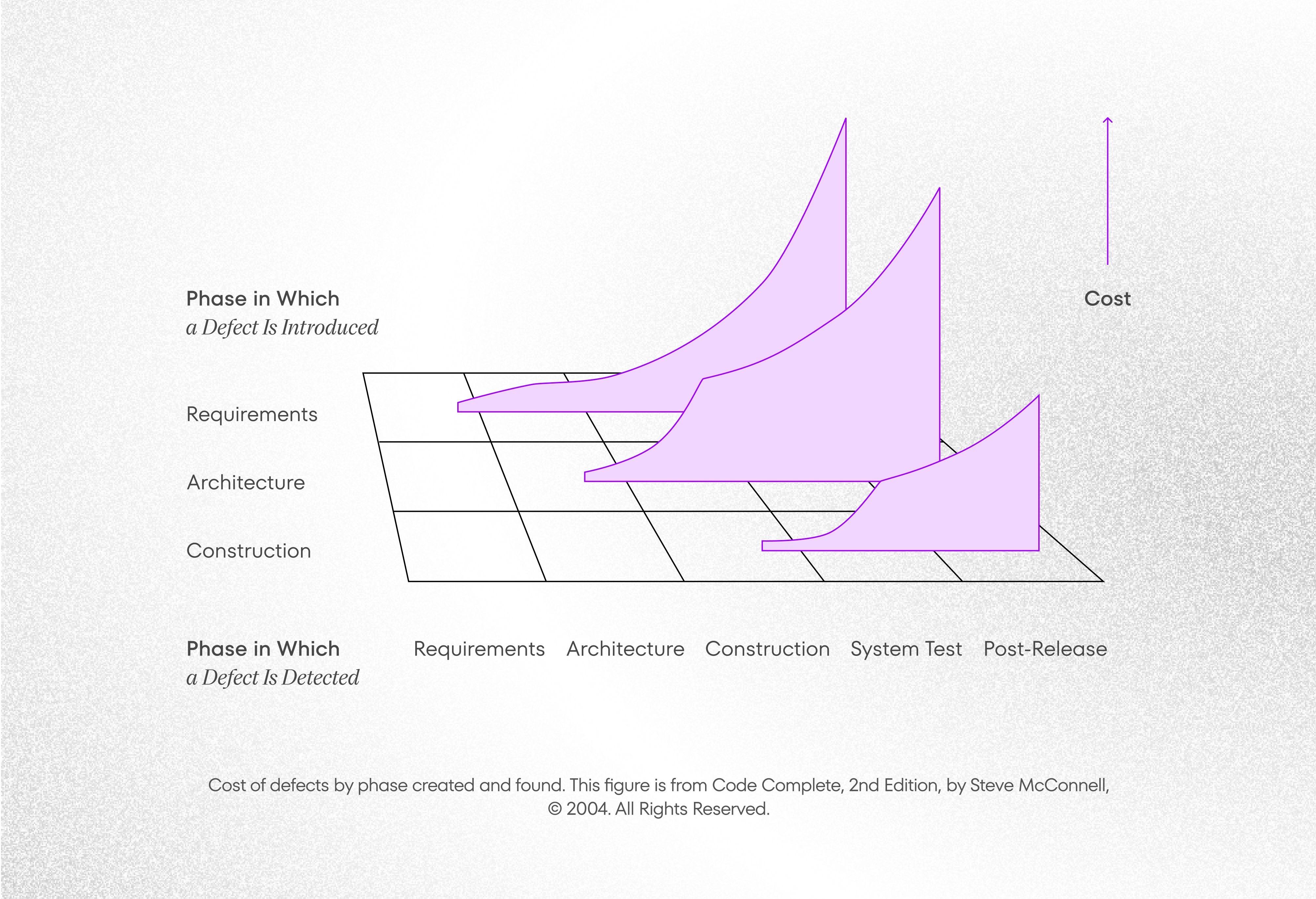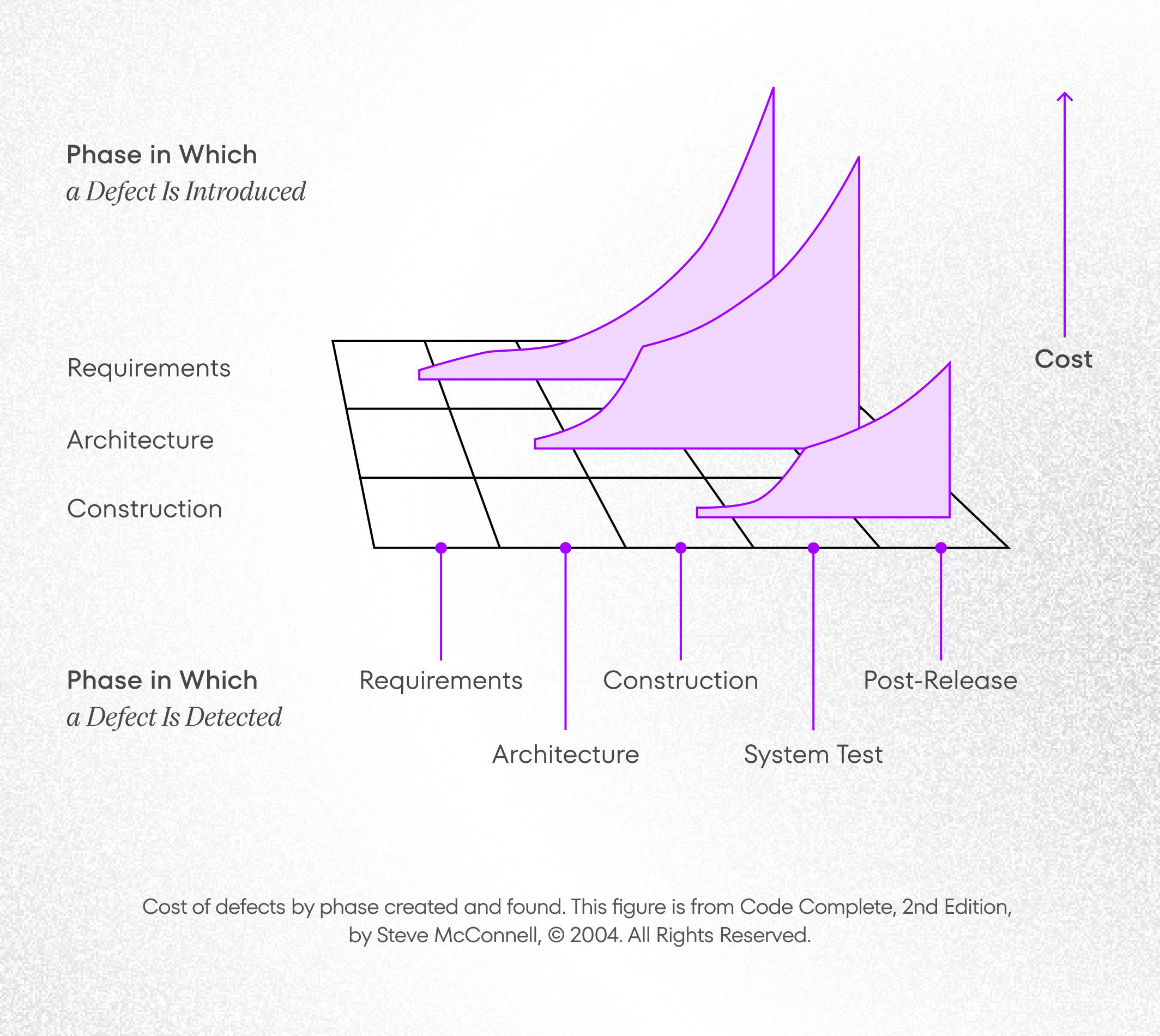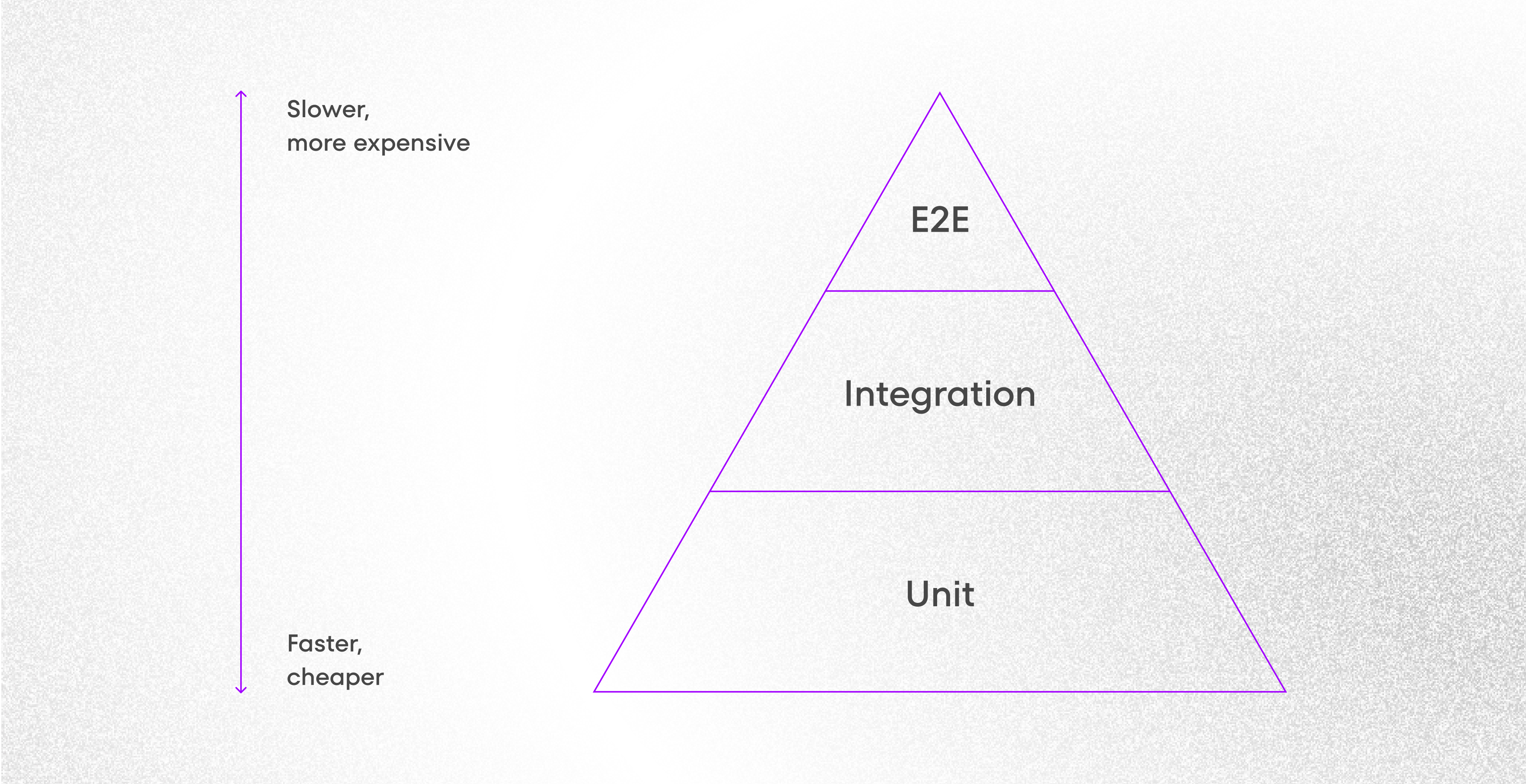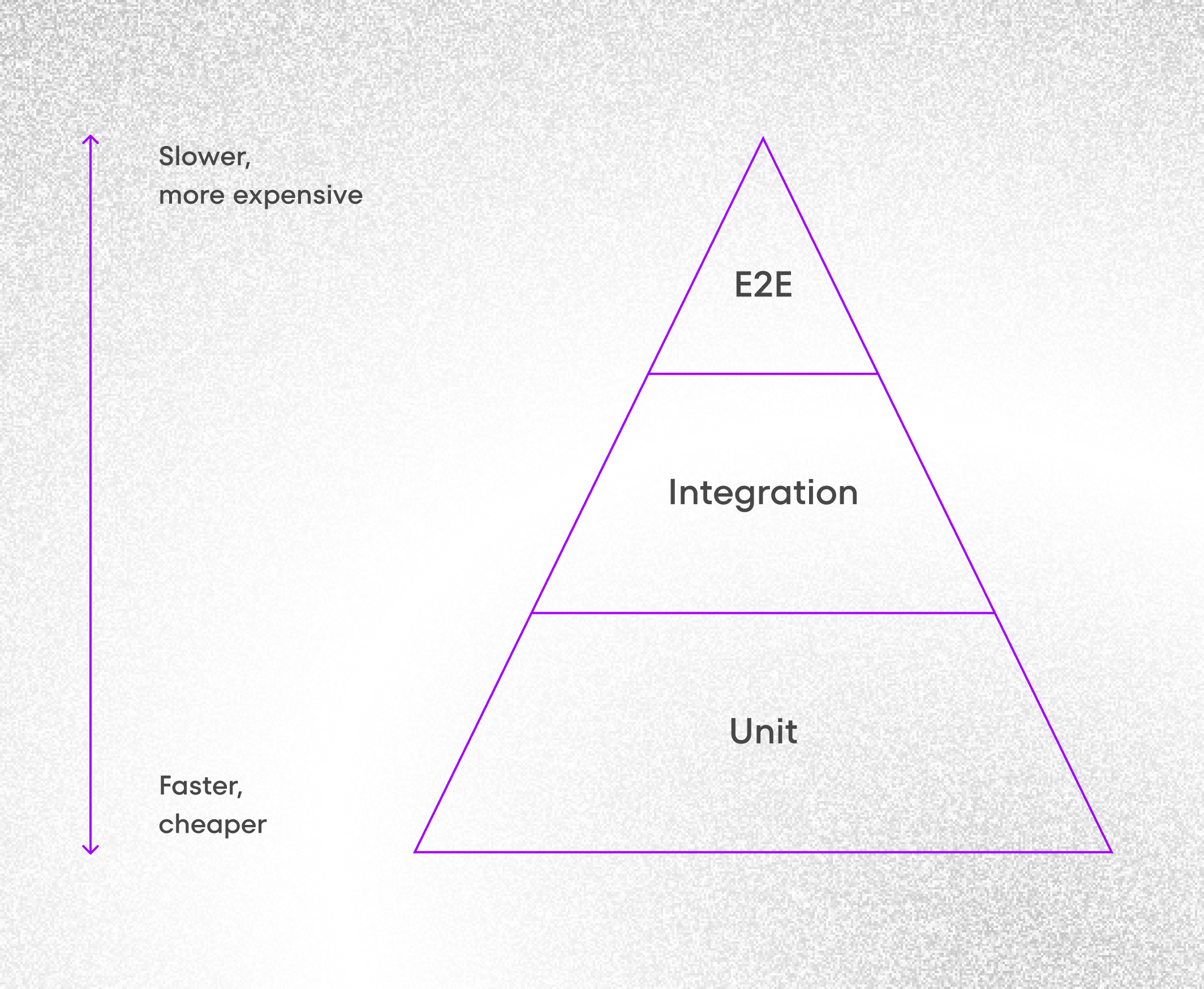September 4th, 2024 | by Michał Gałczewski
Creating Quality Strategy and Establishing QA Processes

Table of contents
In today’s fast-paced world of technology, software development has become the lifeblood of countless businesses. But how can you ensure that the software you’re delivering is of top-notch quality?
The pillars of QA: Ensuring excellence every step of the way
At its core, the QA process acts as a litmus test for whether business and project requirements have been met, and if the end product is indeed the reliable, secure, and stable software envisioned. Its significance goes beyond validation, it’s the linchpin of effective software development, ensuring that every stage of the process is executed with precision and purpose.
Testing isn’t just a formality that improve the overall quality of the software but it’s the foundation of every success of the software project.
Michał Gałczewski Senior QA Manager
Spotting Bugs Before They Bite
Early bug identification is key, as it slashes the costs and efforts required for fixing them down the line. By catching and addressing bugs in their infancy, we prevent them from snowballing into more complex and costly issues later on.
Quality: It’s Non-Negotiable
Testing guarantees that the software not only meets specified requirements but also performs as expected. This commitment to quality translates into heightened customer satisfaction and loyalty, as users get exactly what they bargained for.
Risk Mitigation: Protecting Your Investment
Identifying potential risks and vulnerabilities early on is crucial. By addressing these issues upfront, we minimize the chances of catastrophic failures or security breaches down the road.
Time is Money
While testing demands an investment of time and resources, it ultimately pays dividends by reducing the need for extensive debugging and rework later in the development cycle. After all, it’s much cheaper to fix bugs in the blueprint stage than on the production floor.
User Experience Matters
Thorough testing isn’t just about functionality; it’s also about ensuring a seamless and enjoyable user experience. By ironing out usability issues before release, we pave the way for a smoother and more delightful user journey.
Building Trust, One Line of Code at a Time
A well-tested product isn’t just a testament to its quality; it’s also a badge of honor that builds trust and credibility with users, stakeholders, and customers alike. After all, nothing inspires confidence like a product that delivers on its promises.
Spotting Bugs Before They Bite
Early bug identification is key, as it slashes the costs and efforts required for fixing them down the line. By catching and addressing bugs in their infancy, we prevent them from snowballing into more complex and costly issues later on.
Quality: It’s Non-Negotiable
Testing guarantees that the software not only meets specified requirements but also performs as expected. This commitment to quality translates into heightened customer satisfaction and loyalty, as users get exactly what they bargained for.
Risk Mitigation: Protecting Your Investment
Identifying potential risks and vulnerabilities early on is crucial. By addressing these issues upfront, we minimize the chances of catastrophic failures or security breaches down the road.
Time is Money
While testing demands an investment of time and resources, it ultimately pays dividends by reducing the need for extensive debugging and rework later in the development cycle. After all, it’s much cheaper to fix bugs in the blueprint stage than on the production floor.
User Experience Matters
Thorough testing isn’t just about functionality; it’s also about ensuring a seamless and enjoyable user experience. By ironing out usability issues before release, we pave the way for a smoother and more delightful user journey.
Building Trust, One Line of Code at a Time
A well-tested product isn’t just a testament to its quality; it’s also a badge of honor that builds trust and credibility with users, stakeholders, and customers alike. After all, nothing inspires confidence like a product that delivers on its promises.
Spotting Bugs Before They Bite
Early bug identification is key, as it slashes the costs and efforts required for fixing them down the line. By catching and addressing bugs in their infancy, we prevent them from snowballing into more complex and costly issues later on.
Quality: It’s Non-Negotiable
Testing guarantees that the software not only meets specified requirements but also performs as expected. This commitment to quality translates into heightened customer satisfaction and loyalty, as users get exactly what they bargained for.
Risk Mitigation: Protecting Your Investment
Identifying potential risks and vulnerabilities early on is crucial. By addressing these issues upfront, we minimize the chances of catastrophic failures or security breaches down the road.
Time is Money
While testing demands an investment of time and resources, it ultimately pays dividends by reducing the need for extensive debugging and rework later in the development cycle. After all, it’s much cheaper to fix bugs in the blueprint stage than on the production floor.
User Experience Matters
Thorough testing isn’t just about functionality; it’s also about ensuring a seamless and enjoyable user experience. By ironing out usability issues before release, we pave the way for a smoother and more delightful user journey.
Building Trust, One Line of Code at a Time
A well-tested product isn’t just a testament to its quality; it’s also a badge of honor that builds trust and credibility with users, stakeholders, and customers alike. After all, nothing inspires confidence like a product that delivers on its promises.
Spotting Bugs Before They Bite
Early bug identification is key, as it slashes the costs and efforts required for fixing them down the line. By catching and addressing bugs in their infancy, we prevent them from snowballing into more complex and costly issues later on.
Quality: It’s Non-Negotiable
Testing guarantees that the software not only meets specified requirements but also performs as expected. This commitment to quality translates into heightened customer satisfaction and loyalty, as users get exactly what they bargained for.
Risk Mitigation: Protecting Your Investment
Identifying potential risks and vulnerabilities early on is crucial. By addressing these issues upfront, we minimize the chances of catastrophic failures or security breaches down the road.
Time is Money
While testing demands an investment of time and resources, it ultimately pays dividends by reducing the need for extensive debugging and rework later in the development cycle. After all, it’s much cheaper to fix bugs in the blueprint stage than on the production floor.
User Experience Matters
Thorough testing isn’t just about functionality; it’s also about ensuring a seamless and enjoyable user experience. By ironing out usability issues before release, we pave the way for a smoother and more delightful user journey.
Building Trust, One Line of Code at a Time
A well-tested product isn’t just a testament to its quality; it’s also a badge of honor that builds trust and credibility with users, stakeholders, and customers alike. After all, nothing inspires confidence like a product that delivers on its promises.
Spotting Bugs Before They Bite
Early bug identification is key, as it slashes the costs and efforts required for fixing them down the line. By catching and addressing bugs in their infancy, we prevent them from snowballing into more complex and costly issues later on.
Quality: It’s Non-Negotiable
Testing guarantees that the software not only meets specified requirements but also performs as expected. This commitment to quality translates into heightened customer satisfaction and loyalty, as users get exactly what they bargained for.
Risk Mitigation: Protecting Your Investment
Identifying potential risks and vulnerabilities early on is crucial. By addressing these issues upfront, we minimize the chances of catastrophic failures or security breaches down the road.
Time is Money
While testing demands an investment of time and resources, it ultimately pays dividends by reducing the need for extensive debugging and rework later in the development cycle. After all, it’s much cheaper to fix bugs in the blueprint stage than on the production floor.
User Experience Matters
Thorough testing isn’t just about functionality; it’s also about ensuring a seamless and enjoyable user experience. By ironing out usability issues before release, we pave the way for a smoother and more delightful user journey.
Building Trust, One Line of Code at a Time
A well-tested product isn’t just a testament to its quality; it’s also a badge of honor that builds trust and credibility with users, stakeholders, and customers alike. After all, nothing inspires confidence like a product that delivers on its promises.
Why early detection is crucial?
Studies have repeatedly underscored the importance of nipping defects in the bud, emphasizing the exponential increase in costs associated with fixing issues at later stages of development. This is where the 1:10:100 rule comes into play, driving home the point that early detection and prevention are the linchpins of cost-effective and high-quality software development.


Quality from start to finish – the right approach to software development testing
Early engagement of QA Specialists
From the get-go, QA specialists are an integral part of the project, working tirelessly to verify and validate requirements. By analyzing software requirements with a fine-tooth comb, we ensure they are clear, complete, and most importantly, testable. Additionally, we proactively identify potential risks or issues that may impact the testing process, laying the groundwork for a smooth and effective development journey.
Involvement of QA Engineers
QA engineers roll up their sleeves at every stage of the product’s development lifecycle. They’re not just there to spot bugs, they’re instrumental in creating processes that uncover bugs, flaws, and other defects. Measuring and maintaining the quality of the product prevents issues from snowballing into major headaches. Their proactive approach also helps identify and address potential issues before they rear their ugly heads.
Strategic Test Planning
The process led by Test Manager and QA Team Lead should leave no stone unturned when it comes to test planning. Drawing on project documentation, they craft a Test Strategy that covers all business and process requirements. The Test Automation Architect then steps in to prepare the Test Automation Project, ensuring that every aspect of testing is planned and executed. From identifying deliverables and milestones to selecting the most suitable testing methods and tools, should leave no room for error.
Continuous Monitoring and Improvement
Commitment to quality doesn’t end with test planning, it’s an ongoing process. The team continuously monitors the performance of the processes, ensuring that quality requirements are met every step of the way. This proactive, process-based approach allows us to manage the quality of the product before and during the production process, minimizing the likelihood of costly surprises down the line.
Understanding the landscape – customized Test Strategies
At our core, we believe in the power of personalized solutions. That’s why our approach to testing is anything but one-size-fits-all. Instead, we craft individually tailored test strategies that are specifically designed to meet the unique needs and requirements of each project.
Testing strategies should not be arbitrary, they should be crafted based on thorough analysis and understanding of the project documentation. By delving deep into the intricacies of the project requirements, ensuring that our test strategies are aligned with the overarching business and process objectives, leaving no stone unturned in our quest for excellence.
Beyond the basics – exploring alternative approaches
In addition to our standard testing strategy, we offer a range of alternative approaches designed to address specific challenges and complexities:
Risk-Based Test Strategy
This approach prioritizes testing efforts based on the level of risk associated with different aspects of the software system. By focusing on areas that are most critical or prone to defects, we maximize the likelihood of detecting and addressing high-impact issues, thereby optimizing testing resources and ensuring maximum test coverage.
Hybrid Manual-Automation Risk-Based Strategy
Building on the strengths of both manual testing and test automation, this strategy offers a balanced approach to software testing. During test execution, our testing teams prioritize the execution of test cases based on their relevance to identified risks. High-risk areas receive greater attention, with more extensive testing performed to uncover potential issues. By combining human intuition and creativity with the efficiency and repeatability of automation, we enhance our testing efforts and deliver reliable software at lower costs.
Streamlining development with Continuous Integration (CI)
Adhering to industry best practices and leveraging tools like the test pyramid and continuous iteration is important to ensure efficiency and effectiveness throughout the development lifecycle.
The Test Pyramid: Building a strong foundation
The test pyramid is a widely-used framework that promotes a balanced approach to testing. At the base are fast and cost-effective unit tests, focused on individual components to ensure they work in isolation. Moving up the pyramid are integration tests, which check the interaction between modules or services. Though fewer, they cover broader functionality and help detect integration issues. At the top are end-to-end tests, which validate the system’s overall behavior. While less frequent, these tests offer insights into the software’s performance and user experience.
Following the test pyramid ensures comprehensive test coverage while keeping the test suite manageable, providing timely feedback and supporting rapid iteration and deployment—key aspects of agile development.
Continuous Iteration: Embracing change
In a changing business environment, continuous iteration (CI) is essential. CI is more than a development process—it’s a mindset that focuses on adaptability and responsiveness to evolving requirements, feedback, and market conditions.
With CI, development follows a cycle of improvement, iterating in short cycles to incorporate new insights. This keeps the software aligned with stakeholder needs and business goals throughout development.
Continuous integration and iteration are key to delivering high-quality software. By adopting these principles, teams can navigate software development with agility and precision, driving innovation and delivering value to stakeholders.


One size doesn’t fit all – tailored QA for Every Project
Each project is unique, so testing strategies are customized to meet specific business and process needs. Whether using a risk-based approach or a hybrid of manual and automated testing, the goal is to ensure that all requirements are effectively addressed.
Quality Assurance isn’t just a task; it’s essential to achieving excellence in software development. With experienced QA specialists and strong processes, the focus is on delivering reliable software and peace of mind. By partnering in this effort, the full potential of software projects is unlocked for long-term success.


